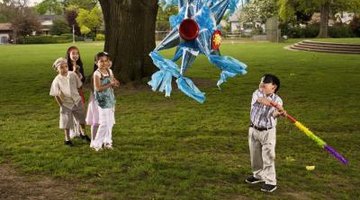Types of Grass for Play Areas
Play areas take a lot of wear, tear and abuse, making it difficult for all but very hardy, deep-rooted grasses to survive. Tough turfgrasses make the best grasses for playing fields because they have deep root systems. Pick the right turfgrass for your playground or backyard and properly fertilize, water and mow it and you will have an impact-resistant surface that will protect your children when they run, play and fall. Occasionally overseed so your turf can stay green and thick all season.
Sun and Shade

Turfgrasses tend to prefer full sun. That's fine for ball fields but not so much for shaded play areas. Bahiagrass, bluegrass, common Kentucky bluegrass, improved Kentucky bluegrass, blue gammagrass, buffalograss, improved bermudagrass, creeping bentgrass, red or creeping red fescue, annual ryegrass, perennial ryegrass, wheatgrass and zoysiagrass are good varieties for open sunny fields.
Bahiagrass, improved Kentucky bluegrass, creeping bentgrass, red or creeping red fescue, annual ryegrass, perennial ryegrass and zoysiagrass also adapt to light shade. Of all the suitable playground turfgrasses, only zoysiagrass can handle full shade.
Soil pH
Most of the listed turfgrasses prefer acidic soils. Only blue gammagrass and wheatgrass varieties thrive in alkaline earth. You may have to treat the soil in shady areas to make it acidic enough to grow turfgrasses that can handle partial or full shade.
Soil Moisture
Bluegrass, common Kentucky bluegrass, blue gammagrass, improved bermudagrass, creeping bentgrass, red or creeping red fescue, perennial ryegrass, wheatgrass and zoysiagrass all prefer well-drained soil. The fescues, wheatgrass, bluegrass and blue gammagrass actually prefer dry soil. Bahiagrass, bermudagrass, improved Kentucky bluegrass and annual ryegrass varieties all prefer moist soil.
Germination
Turfgrasses germinate in anywhere from three to 35 days. The quicker the grass sprouts, the less potential damage can be caused to the soil by a sudden wind or rainstorm. If you are planting during storm season, choose a quicker-germinating turfgrass like bermudagrass (4 to 12 days), bluegrass (6 to 30), improved bermudagrass (10 to 20 days), red or creeping red fescue (10 to 21 days), annual ryegrass or perennial ryegrass (3 to 7 days) and zoysiagrass (7 to 10 days). If you've got quiet weather coming up, you may be able to handle slower germinating varieties of turfgrasses like bahiagrass (3 to 4 weeks), common Kentucky Bluegrass (14 to 30 days), blue gammagrass (15 to 30 days), buffalograss (25 to 35 days) or wheatgrass (14 to 30 days).
Climate
Bahiagrass, bermudagrass, improved bermudagrass and zoysiagrass all grow well in warm to hot climates of the southern and southwestern states. For cooler climates, stick with bluegrass, common Kentucky bluegrass, improved Kentucky bluegrass, blue gammagrass, buffalograss, creeping bentgrass, red or creeping red fescue, annual ryegrass, perennial ryegrass and wheatgrass. Turfgrasses prefer specific climates and, unless you want to spend a great deal of time and energy on maintenance, it's best to stick with varieties specific to your region. Talk to your local agricultural extension service about which turfgrasses work best for your region's climate.
References
Writer Bio
Tom King published his first paid story in 1976. His book, "Going for the Green: An Insider's Guide to Raising Money With Charity Golf," was published in 2008. He received gold awards for screenwriting at the 1994 Worldfest Charleston and 1995 Worldfest Houston International Film Festivals. King holds a Bachelor of Arts in communications from Southwestern Adventist College.
Photo Credits
- Todd Warnock/Lifesize/Getty Images
More Articles



